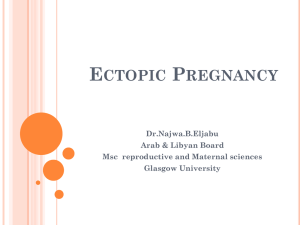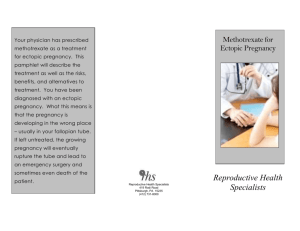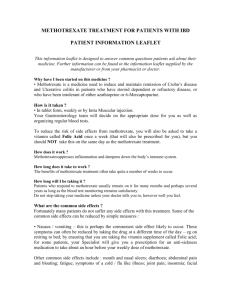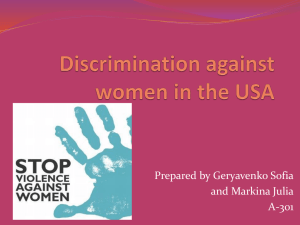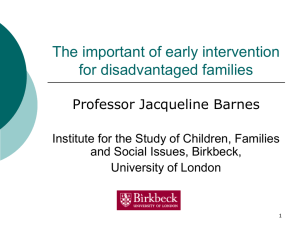Incidence EP
advertisement
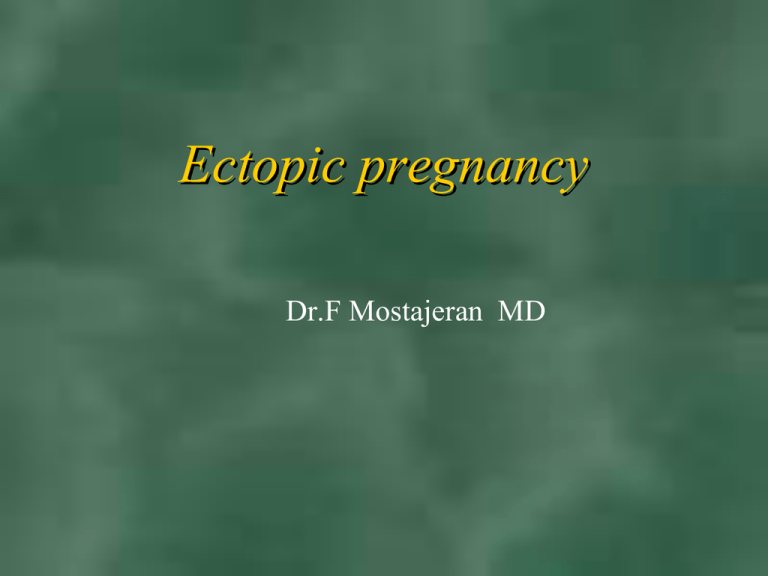
Ectopic pregnancy Dr.F Mostajeran MD Ectopic pregnancy remains Leading cause life/hreatening F- Trimester (morbidity) Medical therapy method terexate as standard first line therop. Surgery Hemorrhage? Medical failures Neglected cases Medical contraindicated Incidence E.P Unprecedented sexual liberties. ↑Ascertainment E.P ↑ART Leading cause maternal death U.S 5-6% all M. death Pathogenesis • Ability tube transport gametes embryos • Clinical picture • Most common site Tub 98-3% • Ampoule – isthmus – fimbrial cornual. • Rarely abdominal – ovarian – cervical. site E.P • Proliferating trophoblast • Tubale wall • Growth may extend luminal mucosa. • Muscularis- serosa full thickness blood vessels • Distorts tube stretches serosa → pain bleeding takes phase. • 80% embryo degenerates. • 50% often clinically silent. • Tubal abortion self limited. Risk factors Needs aggressive monitoring pregnancy immediately after first missed menses High risk • Tubal surgery (21) • Risk factors • Tubal ligation • Tubal Epithelial damage. • Previous E.P (6-8) • I U D , Morning after pill • ART • Moderate risk • Infertility • PID • Multiple sexual partners • Salpingitis Low risk • Cigarette • Vaginal douching first intercourse <18 • Signs and symptoms • Many E.P never produce symptoms rather • Timely diagnosed and treated (H.R) • If diagnosis → delayed → classic triad. • Amenorrhea , irregular V.B , lower ab- pain. • Sudden sever ab pain 90-100% symptomatic patient. • Pain radiating shoulder. • Syncope shock → hemoperitaneum.( up to 20%) • Most common signs ab EX • 90% tenderness ,rebound tenderness in 70%. • P.EX nonspecific. • 2⁄3 C-motion tenderness . • Adnexal mass 50%. • Diagnosis • Diag as early as 4.5 WK. • Visualization is frequently not possible. • Traditional laparoscopic visualization rarely necessary. • Routine diagnostic Tests. • Serial 3HCG. • U.S • Progesterone levels. • U - curettage. Treatment for E.P • • • • • • • • • • Medical management . Methotrexate therapy. Folic acid antagonist DNA synthesis and cell multiplication. Single dose 50 mg/m2 Blunts HCG increment (7) Drop progesterone, 17 × hydroxy progesterone prior to abortion Hemodiamically stable. E.P unruptured less 4cm Eligible for methatrexate therapy. Multiple-dose: tailored weight-E.P responsiveness. • Comparing multiple-dose-laparoscopic salpingostomy. • Patent fallopian tubes. • Subsequent IU pregnancy. • Repeat E.P comparable . Single dose: • Resent metaanalysis 26 studies. • Based on clinical evidence presently available. • Routine use methotrexate single dose IM not as • Effective as multiple dose (tubal rupture↑) • Indication for systemic M-dose methotrexate • No rupture • Tubal size ≤4cm • HCG ≤ 10,000 • Positive F.H heartbeat proceed with caution. Methotrexate by direct injection • • • • • • • Methotrexate E. gestational sac TVS. Resolution within 2 weeks Higher concentrations site of implantation. Less systemic distribution drug 75.1% successfully treated Subsequent p–tubal patency (laparoscopicsystemic Mehta) Subsequent – P, recurrent E.P Methotrexate failure Pain is sever and persistent (>12h 4-12 3-7 after start therapy) Falling HCT Orthostatic hypotension. Side effects • High dose • Bone marrow supp • Hepatotoxicity • Stomatitis • Pulmonary fibrosis • Alopecia • Photosensitivity • Infrequent in E.P therapy Surgical Treatment • 1884 E.P laparotomy salpingectom. • 1953 salpingostomy • Manual fimbrial expression • Segmental resection. • Ruptured E.P • Laparoscopy – laparotomy – salpingectomy. • Inpatients hypovolemic shock. • Surgery is choice. Stable E.P • If methotrexate contraindicated. • Laparoscopic salpigostomy first surgical choice. • Salpingectomy Laparoscopy Laparotomy Expectant management • E.P may resolve spontaneously • 67.2% E.P resolved without surgery (over treats) • Falling 3HCC under 1000 fallowed with conservative expectant management • With low initial and falling HCG Rare types of E.P • Abdominal pregnancy • 1⁄8000 birth • M.M 5.1⁄1000 7.7 higher than other E.P • (Higher due to delay in diagnosis) prognosis poor Primary - Secondary • • • • • • • • Symptoms → normal for pregnancy to sever if time permits Abdominal pain intra abdominal hemorrhage shock Primary rare usually abort Secondary (reimplantation → abortion ,rupture) U.S choice empty uterus If fetus near viability → hospitalization Adequate blood, bowel preparation Placenta removed unless major vessels, vital organ methotrexate Ovarian pregnancy • • • • • • • Most common form abdominal pregnancy less than 3% of E.P Clinical finding similar tubal E.P ab-pain ,V.B Amenorrhea 30% hemodynamic instability → rupture Usually young multiparous cause Treatment → systectomy, wedge resection or oophorectomy Cornual pregnancy or interstitial pregnancy • 4.7% E.P 2.2% M. mortality • Most frequent symptom menstrual aberration • Abdominal pain V.B, shock → rapture uterine(9-12nk) • Risk factor previous salpingectomy • Repeat U.S with Doppler flow studies → early diagnosis • Cornual resection lapa - resection systemic methatraxate local Cervical pregnancy 1⁄12000 Most common risk factor D.C Previous CS IVF • Symptom most common V.B painless • C.EP usually diagnosis incidentally during routine U.S or at time surgery for abortion • Cervix enlarged- globular, distended it appears cyanotic hyperemic soft • Diagnosis – US, MRI , GSOC below C.OS, • Metha, U. Artery embolization, hysterectomy Heterotopic pregnancy • E.P + intrauterine pregnancy 1⁄6778 • Most causes diagnosed after sign symptoms develop admitted for emergency surgery • Lower abdominal pain serial 3HCG not helpful

